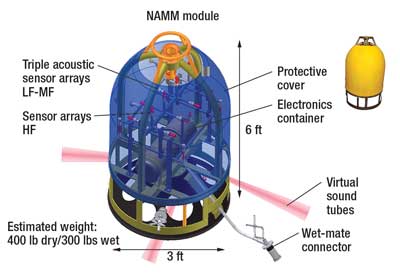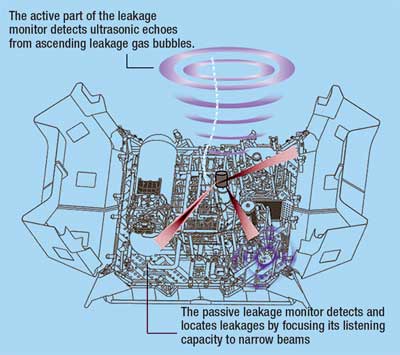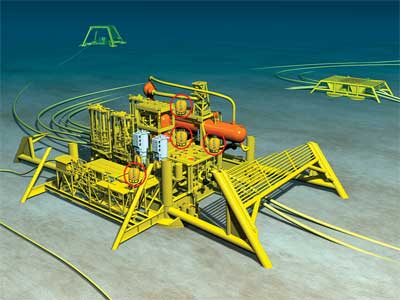Technology from Europe: Norway
Acoustic diagnostic technology improves condition and leakage monitoring offshore
Acoustic diagnostic technology has been used for condition monitoring and leak detection in steadily more advanced offshore projects.
Jens Abrahamsen, Bj�rge AS (Naxys), Bergen, Norway
Located on Norway's west coast, Naxys AS adopted acoustic technology for subsea oil and gas installations on the Norwegian Continental Shelf (NCS). This technology monitors large subsea structures using distant positioned sensors that analyze acoustic emissions in the structure's vicinity. Smaller and easier to operate than existing systems, it provides leakage monitoring and condition monitoring that reduce structural failure. The company was acquired by Bjørge AS in 2005.
CONDITION MONITORING AND LEAK DETECTION
Acoustical Condition Monitoring (ACM) is widely used in everyday life and has steadily become more advanced. It is used widely for detecting cracks, leaks, vibration and friction in land-based process machinery, providing early warning of fatigue failure, thus extending test times and minimizing downtime.
ACM is suited for condition monitoring of subsea installations with succsessful demonstrations carried out at the Troll Pilot subsea Separation and Water Injection plant, the Troll PTG valve skid and the Åsgard B export riser base.
By analyzing acoustic emissions from sensor arrays, diagnostics for several types of subsea equipment can be provided. Ultimately, this will support an operator's maintenance decisions and provide estimates of remaining lifetime of components. Acoustic sensor arrays have several attractive features:
- Multifunctional monitoring�a single system simultaneously monitors several components and conditions
- Detached sensors�sensor arrays are placed at a distance and detached from the monitored components
- Virtual sound tubes�digital signal processing focuses the acoustic sensitivity to certain directions
- Qualified sensor technology
- Ease of installation/maintenance
- A modular and scalable design provides flexibility with localization, interfacing options and redundancy philosophy.
THE SYSTEM
The company has developed its Acoustic Diagnostic System (NADS), which operates from an array of detached acoustical sensors, allowing for subsea diagnostics of rotating machinery, structures, valves and piping. Together with the Acoustic Monitoring Module (NAMM), NADS constitutes a 4D acoustic condition monitoring system, NCM4.
For deep ocean subsea installations, the philosophy of minimizing monitoring and run-to-failure has been justified, because instrumentation requires structural interface/cabling and generally increases the complexity and the failure modes of the various subsea modules. The concept of NCM4 is to monitor large subsea structures using distant positioned sensors. This is obtainable by analyzing acoustic emissions in the structure's vicinity. Whether it's bearing damage, a valve defect or oil/gas leakage, the acoustic picture will change and be immediately observed by NCM4.
The system focuses its sensing capabilities in space, trending over time, thus providing 4D resolution. The diagnostics system contributes to condition-based maintenance and optimization of operational costs, while providing new methods for process parameters measurements.
Detached acoustic sensor arrays provide multifunctional monitoring, including: leaks, choking, cavitations, structural vibrations, erosion, rotational defects (bearing damage, looseness/jamming, unbalance, mechanical breakdown, reduced efficiency), valve defects and other defects, such as loose bolts or hits by large objects.
The digital signal processing allows operators to focus acoustic sensitivity to certain directions and eliminate unwanted noise. A single system having a 1-m diameter footprint will monitor a complete subsea template. The system supports future e-fields and can be connected to an in-house diagnostic center, which is connected to the operators' e-field center. (An e-field provides real-time data handling and actions, holistic models and integrated work processes.)
Acoustic Monitoring Module (NAMM). The Acoustic Module is centrally placed on the structure to be monitored, normally as a single unit. The NAMM contains various active and passive acoustic sensor arrays and an electronics container in a robust cylindrical framework. The communication and power connector is placed on a pigtail hose connection accessible for an ROV, Fig. 1.
 |
Fig. 1. NAMM is the heart of the acoustic diagnostic system.
|
|
Acoustic Diagnostic System (NADS). The diagnostic system is integrated into the NAMM. It continuously receives acoustical raw data and carries out data analysis applicable for leakage, vibration and condition monitoring. Using the previously mentioned sound tubes, the monitoring of the subsea structure in question is organized into �spatial sectors,� for each of which data are carried out. If components of the analyzed data exceed a downloadable threshold, the NADS will respond with an alarm when requested by the control system. For optimum interpretation, NADS needs access run-time parameters, like choke and valve operations. The run-time parameters are input to adaptive filters that respond to the normal noise level. Upon an alarm event, the NADS triggers an upload of snapshot raw data from the NAMM to the topside command control, data presentation and storage module. The software in NADS runs on a dedicated digital signal processor.
Subsea leakage monitor. The leakage monitor is an ultra-sensitive instrument that detects leakages of liquids and gases to the subsea environment at a range of up to 100 m (330 ft). It monitors leakages on subsea processing plants, pipeline plants, pipeline systems and in subsea valves. A single instrument has a wide coverage area for monitoring entire subsea installations. The instrument is self-contained with flexible interface options, from simple alarm and warning outputs to a network version with an integrated web server. An autonomous version of the instrument is also available; alarm messages are transmitted via acoustical modems to the nearest platform, Fig. 2.
 |
Fig. 2. An autonomous version of the leakage monitor transmits warning messages to the nearest platform.
|
|
ACOUSTIC ELECTRICAL CONDITION MONITORING
Electromagnetic probing is employed for detection of geological formations and reservoirs and for discovering the location and direction of seagoing vessels. Taking the technology used in these disciplines, the company can deliver a passive electrical monitoring system for detection of electric ground faults or other types of damage to equipment governing electromagnetic signatures.
In its simplest version, the electric sensor system will record, in real time, the amplitudes of the electric signatures at a distance from the monitored components. The signature is expected to have a normal state when the components are functioning according to plan, and to deviate from the normal state when a fault occurs. The AECM system is a good example of a stand-alone system that monitors underwater equipment. The system consists of three parts:
- The NAMM�the subsea module with sensors and processing unit.
- Cabling for topside/subsea communication and power distribution.
- Topside PC and software for controlling/storage of raw/processing of data from the NAMM.
Electric subsea technology has been in use for more than 15 years and is becoming a supplement to electro-hydraulic systems. This is because of deeper water, longer offsets, marginal fields, tie-ins to subsea systems, subsea processing, subsea production boost systems (multiphase pumping systems), reliability concerns with electrical cables, connectors and increased environmental factors.
TECHNOLOGY IN USE
On Dec. 16, 2006, the Norwegian government approved Statoil's plans for Improved Oil Recovery (IOR) from Tordis field on the NCS. New technology will allow the Tordis IOR project to boost recovery by about 35 million bbl of oil, increasing the recovery factor to 55% from 49%. The project will be the first in the world to adopt full-scale subsea separation, Fig. 3.
 |
Fig. 3. IOR equipment to be installed at Tordis field in 2007. Sensor array provides 3D monitoring.
|
|
Tordis IOR will use three of the company's leak detectors and one Condition Monitoring Module, including both acoustic and electric field sensors. The acoustic sensors will monitor the water injection pump, the multi-phase pressure booster and the de-sander unit. The electric field sensors will monitor ground failures on connectors.
Ormen Lange. The development of giant Ormen Lange gas field off the coast of Møre and Romsdal is the largest industrial project ever carried out in Norway. When production commences this fall, gas from Ormen Lange will be able to meet up to 20% of Britain's gas demand for as long as 40 years. The company has delivered leakage and condition monitoring for the field's seabed templates. One sensor module monitors the 44 x 33-m template, with the system providing location and magnitude of any leak, structural vibration or valve malfunction. Additionally, the company is delivering systems for vibration monitoring of the free spans (unsupported sections) of Ormen Lange's two 30-in. pipelines bringing the gas to shore. Sensor package synchronization and data transfer are being done acoustically. 
|
THE AUTHOR
|
|
Jens Abrahamsen founded Naxys in 2001 and followed the company when it was bought by the Bjørge group in 2005. As vice president, he leads the subsea monitoring section within the Bjørge group. Prior to establishing Naxys, he held the position of manager of projects for Geco Defense, where he was responsible for advanced subsea naval technology. Mr. Abrahamsen has an MSc degree in hydrodynamics.
|
|
|





